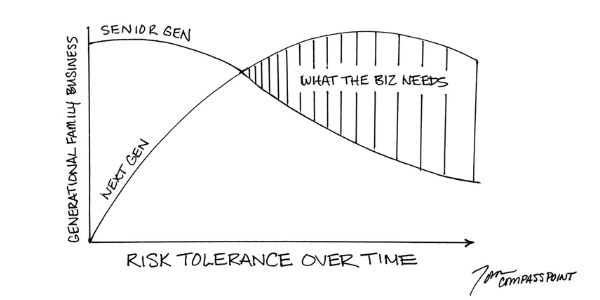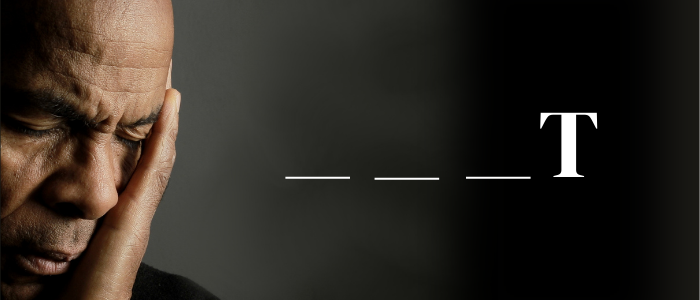FAMILY DYNAMICS / GOVERNANCE
The Game of Risk – Tolerance vs Time

As I was working on this blog, a timely piece of wisdom from Seth Godin hit my inbox. Seth writes:
“We talk about risk like it’s a bad thing. But all forward motion involves risk.”
He is spot on.
There was risk in starting the business.
Risk with each new hire.
Risk growing a geographical market.
Risk with the newest product launch.
Risk with expanding your production line.
Risk is a constant in business. How many times did someone tell you starting a business was risky? Yet YOU did it anyway.
What changes is how we perceive risk.
And that shift in perception comes down to time span.
Facilitating planning sessions with multi-generational companies, I have witnessed this dynamic in action. The Next Gen bubbling with ideas that tap on the latest trends and technologies, while the Baby Boomers & Gen X leaders list out all the things that might derail the company with these “risky” ventures.
For Next Gen, they have the energy, ideas, and time to recover financially, physically, and emotionally if a plan doesn’t go as designed. Their time span of risk is long because they are young.
Ah, but the Senior Gen has a different view. They remember a time when they were willing to take on a LOT of risk – most have the “wounds” to prove it. They now see an economic landscape that is changing exponentially faster than when they started out and their tolerance for risk is receding. The Senior Gen is aware that they have a shorter time span – less energy to recover, and literally less time to recoup if there is a financial misstep.
Same initiative. Two entirely different perceptions of risk.
Next Gen’s perception vs Senior Gen’s perception.
The question is how does a family business strike a balance?
The discussion of the time span of risk is critical for families in transition. It emphasizes even more how critical it is to develop Next Gen now to be the leaders of tomorrow because successful businesses must take risks. How much, how fast, amount of exposure, etc… are all factors to be taken into consideration.
A brutal fact: the business that starts to limit risk, holds back on innovative and forward-thinking, begins a slow decline to death. You can’t coast in business.
There’s no changing this time span of risk. It just is. That is why it is so important to recognize it and begin to move the Next Gen into senior leadership, including the CEO seat BEFORE the avoidance of risk starts to hurt the company. When each generation recognizes where the other one is coming from and finds some common ground, then the Senior Generation can ultimately have confidence in Next Generation is weighing the risk to take the business in the best direction.
This balance comes from having good governance in place, talking as a family, and being crystal clear on what the big picture is for the family business. Where you want to go and the values you want to attain/retain, who you want to be in the community, what you want to do with your brand, etc. When everybody is aligned to that, you have set the Next Gen – and the family – up for success.
And I guarantee you it’s going to be different than what the Senior Gen is currently doing.
Markets change, people change, customers change, and your business must change in order to remain relevant in the marketplace. Don’t fight that. It is going to happen.
Risk is not a bad thing WHEN we recognize risk for the teacher it is:
● Teach the Next Gen what risk looks like within your industry
● Talk of the trigger points you experienced
● Explain it is okay to pause and seek the counsel of advisors
● Coach the value of stepping back to reassess and reposition the company’s path
● Mentor the Next Gen to manage the risk they will have to take on to make the business successful during their time at the helm.
And soon enough it will be their turn to do the same with their “Next Gen”. That is the ebb and flow of any legacy business.
“We don’t try something simply because there’s no downside. Instead, we intelligently choose projects where the downside is understood and the work is worth doing.”
Thanks, Seth. Could not have summed it up any better myself.
You may also like…

BLOG | FAMILY DYNAMICS / GOVERNANCE
The 4-Letter Word Owners Can’t Afford NOT to Talk About: EXIT
I’ve had my share of family business owners who avoid discussing this four-letter word to the point of pure denial, quickly ending the conversation when this word bubbles up. The word? E-X-I-T. It sounds so final. The brutal truth is that 100% of owners exit the business, yet only 50% – just 1 out of 2 owners – will do it on their terms...
Read More
BLOG | LEADERSHIP
Family Business Peer Groups are Gamechangers for the Next Gen
Many family-led companies hire business consultants to grow the business. Some even send their emerging leaders to personal development programs. But there is a gap – and it’s a BIG one.
Read More
BLOG | PEOPLE / TALENT
Unlocking the Golden 5% in Your Employees
The Golden 5% is the full expression of our ability, multiplied by our maximum possible effort, multiplied by our full contribution of heart. It is the performance equivalent of what we offer in a deeply loving relationship – the absolute best of ourselves. And yet, we rarely give it or reliably inspire the giving of it by others in organizations. Why?
Read MoreWhere Family Businesses Come to Grow & Learn
At Compass Point, we make it easy to get insights, training, tools, and articles straight to your inbox and help family business owners and their team continue to grow, learn, and lead.


